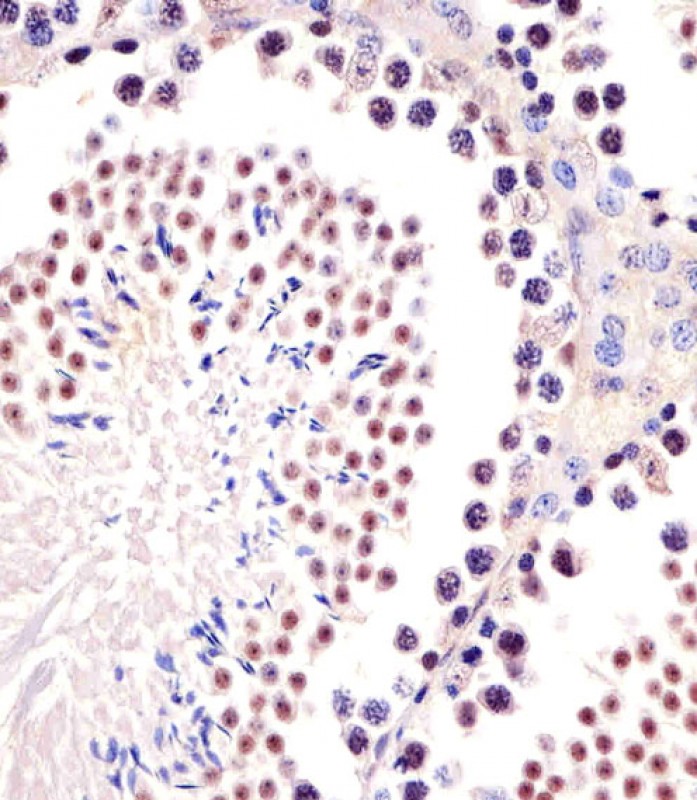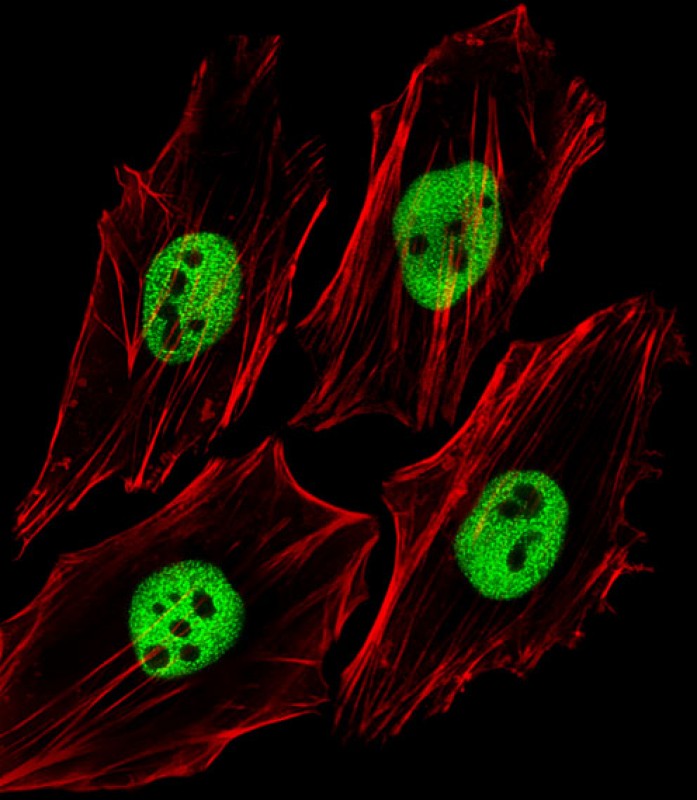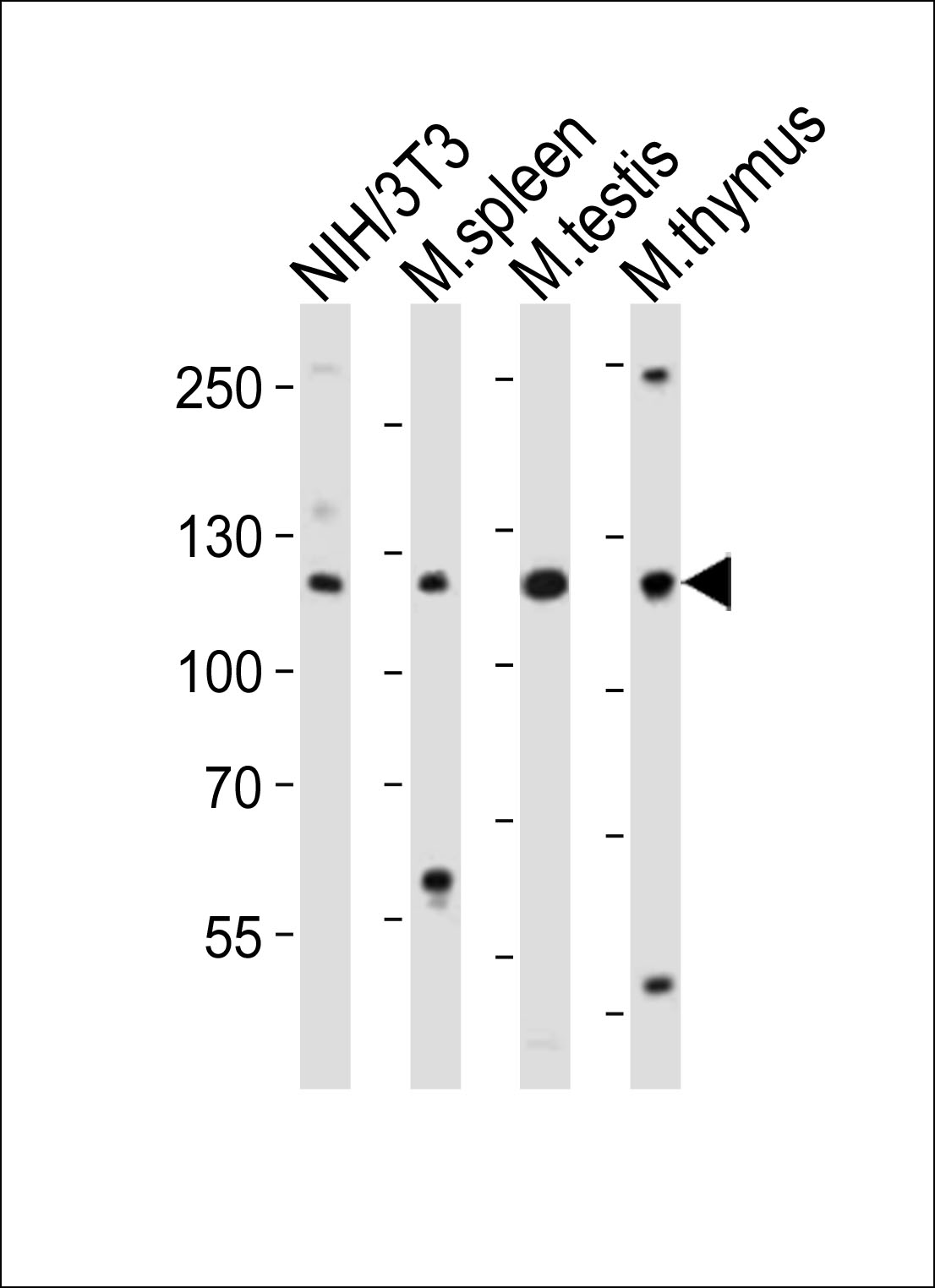(Mouse) Trim24 Antibody (C-term)
Purified Rabbit Polyclonal Antibody (Pab)
- 产品详情
- 实验流程
- 背景知识
Application
| WB, IF, IHC-P, E |
|---|---|
| Primary Accession | Q64127 |
| Reactivity | Human, Mouse |
| Host | Rabbit |
| Clonality | Polyclonal |
| Isotype | Rabbit IgG |
| Calculated MW | 116657 Da |
| Gene ID | 21848 |
|---|---|
| Other Names | Transcription intermediary factor 1-alpha, TIF1-alpha, 632-, E3 ubiquitin-protein ligase Trim24, Tripartite motif-containing protein 24, Trim24, Tif1, Tif1a |
| Target/Specificity | This Mouse Trim24 antibody is generated from a rabbit immunized with a KLH conjugated synthetic peptide between 789-843 amino acids from the C-terminal region of Mouse Trim24. |
| Dilution | WB~~1:1000 IF~~1:25 IHC-P~~1:100~500 E~~Use at an assay dependent concentration. |
| Format | Purified polyclonal antibody supplied in PBS with 0.09% (W/V) sodium azide. This antibody is purified through a protein A column, followed by peptide affinity purification. |
| Storage | Maintain refrigerated at 2-8°C for up to 2 weeks. For long term storage store at -20°C in small aliquots to prevent freeze-thaw cycles. |
| Precautions | (Mouse) Trim24 Antibody (C-term) is for research use only and not for use in diagnostic or therapeutic procedures. |
| Name | Trim24 |
|---|---|
| Synonyms | Tif1, Tif1a |
| Function | Transcriptional coactivator that interacts with numerous nuclear receptors and coactivators and modulates the transcription of target genes. Interacts with chromatin depending on histone H3 modifications, having the highest affinity for histone H3 that is both unmodified at 'Lys-4' (H3K4me0) and acetylated at 'Lys-23' (H3K23ac) (By similarity). Has E3 protein-ubiquitin ligase activity. Promotes ubiquitination and proteasomal degradation of p53/TP53. Plays a role in the regulation of cell proliferation and apoptosis via its effects on p53/TP53 levels. Up-regulates ligand-dependent transcription activation by AR, GCR/NR3C1, thyroid hormone receptor (TR) and ESR1. Modulates transcription activation by retinoic acid (RA) receptors, such as RARA. Plays a role in regulating retinoic acid-dependent proliferation of hepatocytes. Required for normal transition from proliferating neonatal hepatocytes to quiescent adult hepatocytes. |
| Cellular Location | Nucleus. Cytoplasm. Note=Detected in the cytoplasm of the zygote (PubMed:16880268). Translocates into the pronucleus at the time of genome activation (PubMed:16880268). Colocalizes with sites of active transcription (PubMed:10610177). Localizes to sites of DNA damage (By similarity). {ECO:0000250|UniProtKB:O15164, ECO:0000269|PubMed:10610177, ECO:0000269|PubMed:16880268} |
| Tissue Location | Detected in embryonic and adult liver. Detected in zygote and throughout embryogenesis (at protein level). Detected in all adult tissues, with the highest expression level in testis |
For Research Use Only. Not For Use In Diagnostic Procedures.
Provided below are standard protocols that you may find useful for product applications.
BACKGROUND
Transcriptional coactivator that interacts with numerous nuclear receptors and coactivators and modulates the transcription of target genes. Interacts with chromatin depending on histone H3 modifications, having the highest affinity for histone H3 that is both unmodified at 'Lys-4' (H3K4me0) and acetylated at 'Lys-23' (H3K23ac) (By similarity). Has E3 protein-ubiquitin ligase activity. Promotes ubiquitination and proteasomal degradation of p53/TP53. Plays a role in the regulation of cell proliferation and apoptosis via its effects on p53/TP53 levels. Up-regulates ligand- dependent transcription activation by AR, GCR/NR3C1, thyroid hormone receptor (TR) and ESR1. Modulates transcription activation by retinoic acid (RA) receptors, such as RARA. Plays a role in regulating retinoic acid-dependent proliferation of hepatocytes. Required for normal transition from proliferating neonatal hepatocytes to quiescent adult hepatocytes.
REFERENCES
le Douarin B.,et al.EMBO J. 14:2020-2033(1995).
le Douarin B.,et al.EMBO J. 15:6701-6715(1996).
Zhong S.,et al.Nat. Genet. 23:287-295(1999).
Seeler J.-S.,et al.Mol. Cell. Biol. 21:3314-3324(2001).
Torres-Padilla M.E.,et al.J. Cell Biol. 174:329-338(2006).
终于等到您。ABCEPTA(百远生物)抗体产品。
点击下方“我要评价 ”按钮提交您的反馈信息,您的反馈和评价是我们最宝贵的财富之一,
我们将在1-3个工作日内处理您的反馈信息。
如有疑问,联系:0512-88856768 tech-china@abcepta.com.























 癌症的基本特征包括细胞增殖、血管生成、迁移、凋亡逃避机制和细胞永生等。找到癌症发生过程中这些通路的关键标记物和对应的抗体用于检测至关重要。
癌症的基本特征包括细胞增殖、血管生成、迁移、凋亡逃避机制和细胞永生等。找到癌症发生过程中这些通路的关键标记物和对应的抗体用于检测至关重要。 为您推荐一个泛素化位点预测神器——泛素化分析工具,可以为您的蛋白的泛素化位点作出预测和评分。
为您推荐一个泛素化位点预测神器——泛素化分析工具,可以为您的蛋白的泛素化位点作出预测和评分。 细胞自噬受体图形绘图工具为你的蛋白的细胞受体结合位点作出预测和评分,识别结合到自噬通路中的蛋白是非常重要的,便于让我们理解自噬在正常生理、病理过程中的作用,如发育、细胞分化、神经退化性疾病、压力条件下、感染和癌症。
细胞自噬受体图形绘图工具为你的蛋白的细胞受体结合位点作出预测和评分,识别结合到自噬通路中的蛋白是非常重要的,便于让我们理解自噬在正常生理、病理过程中的作用,如发育、细胞分化、神经退化性疾病、压力条件下、感染和癌症。








